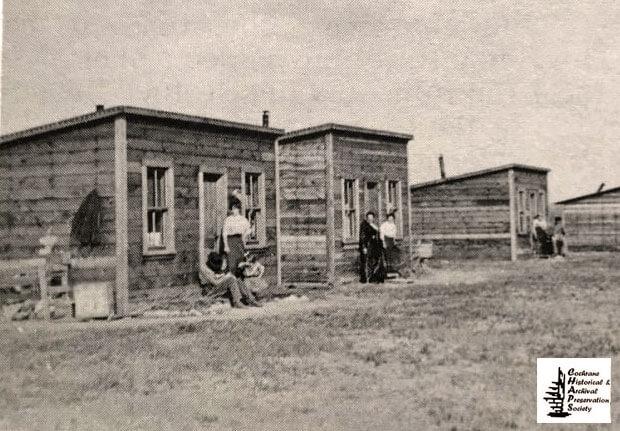The feature image is of the Miner’s shacks at Mitford.
MINING IN THE COCHRANE AREA — by M. E. Spicer
Several attempts at mining coal took place over the years in the Cochrane area. Most of the mines were abandoned within a short period of time. First ones to search for coal in the area, as far as there is any record of, were Albert McMasters, Charles Bannatyne and Walter Elliot. No doubt others searched for it prior to the railway coming through. In 1885 several efforts were made to establish coal mines in the area, and one gentleman by the name of Chaffey, purchased mining rights in what was known as the “Big Hill” location and he formed the Bow River Mining Company. The Big Hill location was the name given to a promising coal site on the south side of the Bow River, opposite the mouth of Coal Creek. A coal seam was struck a few feet below the surface. In 1886 Mr. Chaffey went into partnership with Mr. Merrill and a short time later Mr. Chaffey dropped out of the Company. The mine was not a success and late in 1886 it flooded.
In January 1887, Merrill removed the machinery and abandoned the mine. The location was sold to J. W. Vaughan who tried mining some coal from it but, late in 1887, he abandoned the mine also. He started prospecting on the north side of the river around the mouth of Coal Creek and soon found a promising seam just east of the creek about three-quarters of a mile above its mouth. A shaft was sunk but Mr. Vaughan was faced with the problem of transporting the coal from the mine to the railway.
The Betsy Rail Line passed a short distance north of the mine and this seemed the obvious solution to the transportation problem. In June 1888, Tom Cochrane and Algernon St. Maur purchased two-thirds interest in the mine and constructed a spur line from the mine to the sawmill track.
In 1890 W. Vaughan evidently sold out his interest in the mine because records show that at a later date the mine was leased to J. H. McNeil. The mine was abandoned in 1890. The slag pile from this mine can still be seen from the 1A Highway west of Cochrane, at Coal Creek.
In 1908 a mine was opened up on Section 13-26 5-5, by Mitford Collieries Ltd. This mine was known as the Valerie Mine. J. Russell and D. Gray were the mine managers and the mine surveyor was F. Bell. The mine was shut down in 1915 with a total production of 20,532 tons.
In 1917 a mine was opened on 17-26-5-5, known as the Radnor mine. The owner was H. E. Lyon with manager J. C. Greenwood. It was abandoned in April 1919, as the water broke into the mine. The total production was 150 tons.
Phillips and Company Ltd. opened a mine on 18-26-5-5 in 1917. The mine manager was John Robertson. It was closed down September 1918, with a total production of 25 tons.
Bonnie Brae Coal Company opened a mine on 6-26-4-5 in October 1911. The mine manager was S. D. McCorkindale; 283 tons were mined and it was shut down in 1912 because the machinery needed replacing and there was a shortage of funds to continue operation. The same mine was reopened in 1924 by W. M. McGlashing. He took out 227 tons. The mine flooded and funds to operate it ran out so it was closed down.
In 1932 Western General Agencies opened a mine on 19-25-4-5. The manager was C. C. Walker. This location was on the Jumping Pound. There is no record of any coal being mined and it was abandoned in 1933.
Duncan Shelly operated the stone quarries north of Cochrane. He tested a number of outcroppings and in 1908 he opened up a stone quarry. The outcroppings were along the northwest side of the valley of Big Hill Creek. The formation of stone mined from the quarries yielded the finest of building stone. The stone was buff in type, but there were variations in grain and colour. The workings were about one and a half miles north of Cochrane at a considerable elevation above the creek. Desirable stone was only found in the upper zone. Considerable overburden and a lot of stone that was of no value, plus the steepness of the banks, restricted development to numerous small openings in the escarpment.
The offices and the cutting plant were located in Calgary. Mr. Shelly advertised in England for stone cutters and masons but he also hired local men to work in the quarry. In the summers of 1911, 1912, and 1913, three quarries were in operation and two hundred men were employed.
Transportation of the stone to the railway was a big problem. The stone had to be hauled to Cochrane and loaded on cars to go into Calgary to the cutting plant. A large number of buildings in Alberta were built using stone from the Shelly Quarries; among some of the buildings are several schools in Calgary. Some of the sandstone buildings have been torn down but there are still some left in the City, for people to admire. The quarries started closing down in 1918 and by the early twenties were completely closed down.

